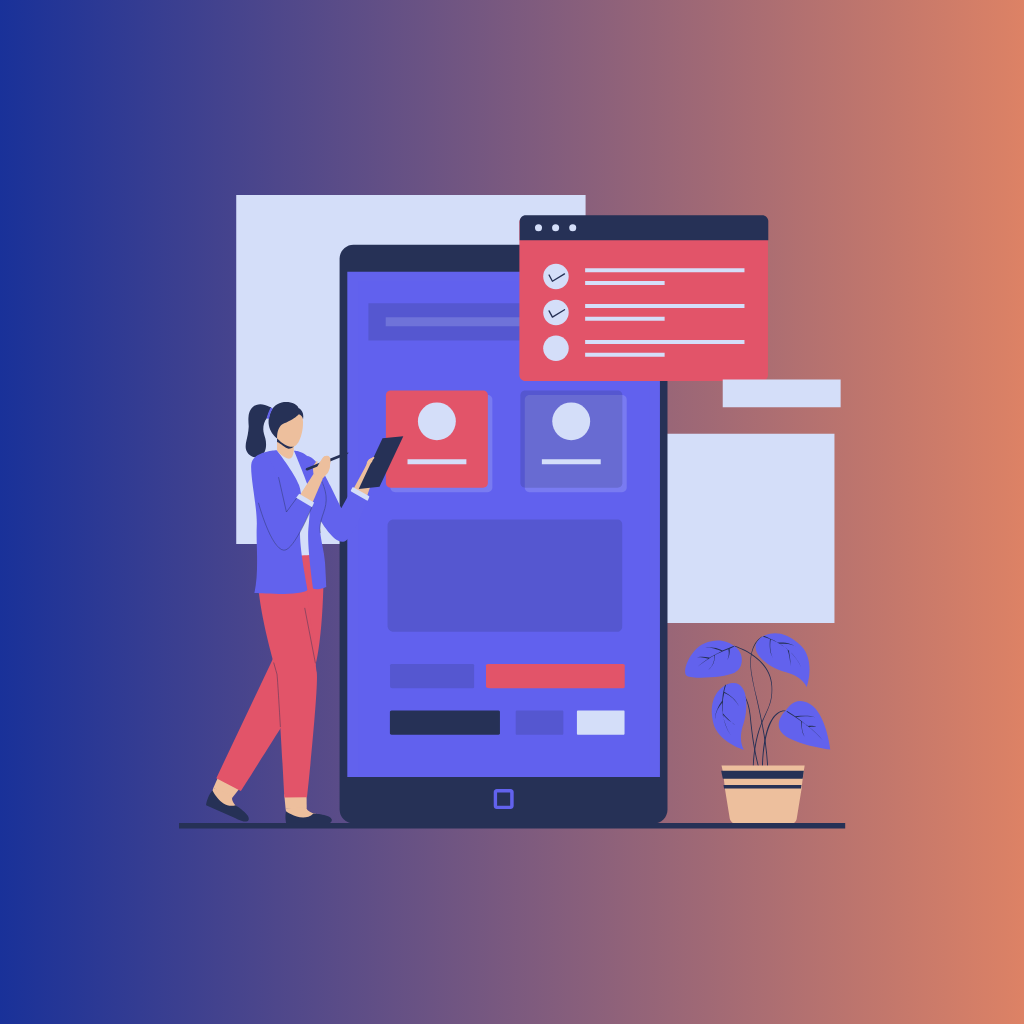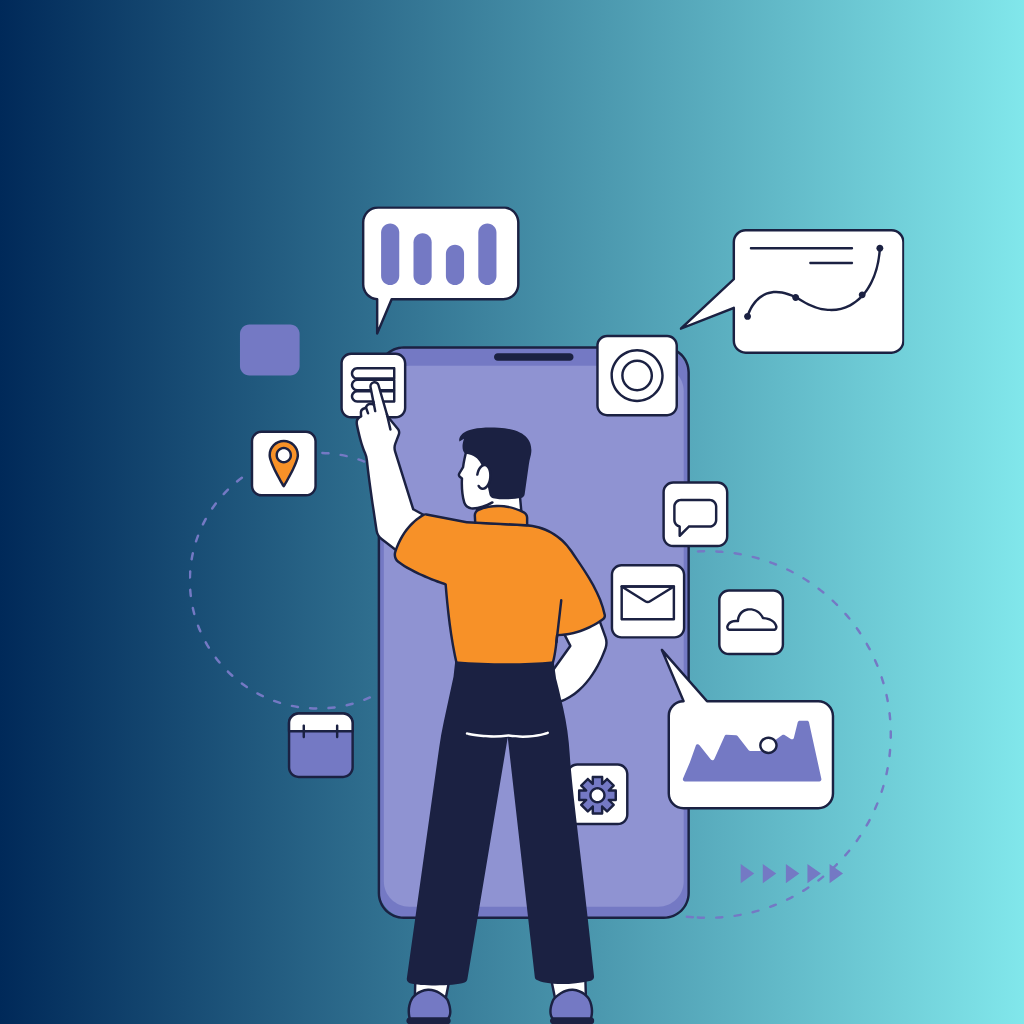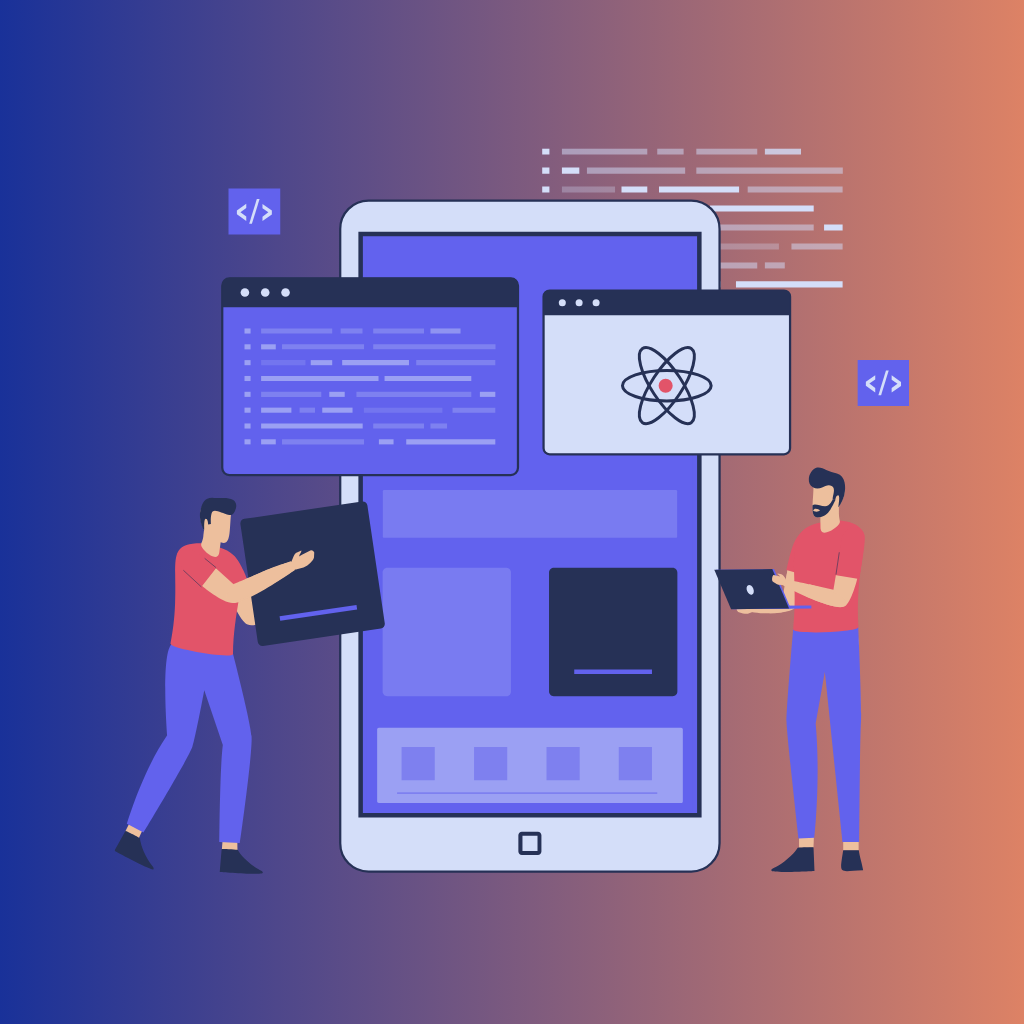It is pretty clear that ensuring an app design is relevant from the developer's point of view and intends to be recognized in the competitive market are the most critical factors. Following new trends in design would make a world of difference in user experience, engagement, and, last but not least, success in the app marketplace. This blog post is going to take a look at the latest mobile application design trends and what there is to expect in the future.
Mobile app design is ever-changing, charmed by new technologies and the shape of user expectations. New ideas every year are the hallmark of innovations that carve the façade and feel of apps. This is a highly dynamic world, with trends and waves able to make or break the success of apps.
Over the years, there has been a morphing in the design of mobile applications. This application was designed purely for its first function, with the primary intent to be friendly to the users. As technology has advanced, this has changed to better experiences by pursuing visually appealing and modern interfaces that are, however, extremely functional. Much of the change took place due to expertise, technological changes, and ways started by people to interact with the apparatuses.
Key Trends Defining the Year Gone By
- Minimalism Major minimalist trends continued to be clean and simple designs with plenty of white space. These further help to eliminate clutter, meaning no hard time for a user to move around a webpage. One can say that apps like Instagram and Airbnb have taken an extremely user-centered and focused way.
- Dark Mode It gained popularity when users started to prefer dark mode over the native light user interface. This will put less load on the eyes under low light, and in turn, this will save even the battery power of OLED screens. The applications include WhatsApp, Twitter, and Facebook, among others, that have dark modes introduced with their color theming.
- Microinteractions Microinteractions are the elements associated with almost invisible animations; they guide one through an app or simply provide feedback on action taken so that the experience is channeled into something more engaging. They include buttons, which change color when touched, and pop-up messages, just to name a few. For example, popular apps, such as those designed like Tinder, have this kind of micro interaction that makes the user experience enjoyable.
Why These Trends Were Important
- Optimized User Experiences Some of the trendy user experience techniques are minimalism and micro-interactions, where the users can explore their quest without getting lost in information. At the same time, micro-interactions respond instantly and make the user feel that the application is alive and responsive.
- Comfortable and Fitted The availability of dark mode brought much personalization that the user would be very comfortable with, especially in changing lighting. This turned notably corresponding to the trend of user-centered design.
- Aesthetic Appeal and Function Both the minimalism and dark mode trends increase the functionality of this app and its aesthetic. In addition, the clean, minimally cluttered interface further gives the appropriate visual appearance. Added to this, dark mode gives a quite modern touch to the app's appearance.
In a word, from its birth to now, simplicity, engagement, and users' comfort are what characterize the outlines of all mobile app designs. These trends, therefore, set the stage for innovative design elements that enable most apps of today and in the future to strive and develop user-friendly user interfaces that will be easy on the eyes and intuitive to the users.
I. What's New in Mobile App Design
Bold Typography
Big, bold typography is one of the staples in contemporary mobile application design. It simply reasons that big, thick fonts help to notice flavors from a distance. Apps themselves, such as Headspace and Spotify, used bold typography that created vivid visual hierarchies to make significant information pop.
Implications for Readability and User Engagement
Among the benefits of bolding a typography is an improvement in its readability. Small texts quickly become scannable and readable with a big enough font size. This will increase user engagement due to the intense visual effect created. Therefore, users can finally quickly determine essential messages, the more likely they are to navigate effectively and remain engaged with the application.
Neumorphism
Neumorphism is the creation of surfaces that look somehow soft, extruded, and plastic, much like real-life buttons—a marriage between skeuomorphism and flat design. It is, in a way, a union between skeuomorphism that desperately reaches out in a bit to look like reality textures of the natural world and flat design that is entirely 2D. This is by adding 3D highlights and shadows that are supposed to create a touchable 3D effect.
Samples and Visual Appeal
It gives an aesthetic appearance to applications like Weather and Clock, at the same time integrating the sensibility of touch. These smooth, realistic things call out for the user to interact with the app.
3D and Immersive Content
From there, 3D graphics and animation are integrated into a mobile app design. 3D graphics combined with animation provide intensity in the experience of user interaction, for instance, in exactly how the IKEA Place App helps users by previewing the furniture in 3D models in their living place.
How these elements make the user experience better
For instance, applying real-life aspects and interactivity will go an extra mile with the animation features and 3D graphics in features. They help to manage and understand data very intuitively on top of complicated data. This brings more satisfaction to the user, making it possible for them to stay on an app longer because of the immersive feelings.
Voice User Interface (VUI)
With voice commands growing naturally, the VUI is only taking more importance with each passing day. We have seen how applications such as Google Assistant and Alexa have set the bell for voice user interfaces to such an extent that the whole world has been taken by storm with this hands-free and efficient way of tasking.
Sample of Applications on Which VUIs Have Been Implemented Effectively
For instance, according to reports, Spotify, like Uber and most others, is incorporating the VUI directly into its systems to make its service more usable. For instance, a user can tell Spotify to play a particular song or ask Uber to book a ride due to VUI. This then makes the interaction smooth and efficient.
Augmented Reality
The design of mobile applications that are being changed with augmented reality will turn into a more interactive and real-world setting. The digital overlay on the natural world will take on a genuine potential to physically enrich user experiences. AR technologies are used to make apps fun and interactive, such as in Pokémon GO and Snapchat.
Real-life Examples and Their Fables of Success
Mobile has taken a different turn with the introduction of Pokémon GO. Using location-based technology has augmented the world in and around the user, turning the real world into a sensation overnight. With wide popularity, Snapchat's filters spur user engagement and content creation; this gives one a peek at how AR can make the user experience richer and applications more popular.
In other words, bold typography, metamorphism, 3D, immersiveness, voice user interfaces, and AR are just a few of the critical components in making user interaction more engaging and better. These trends will make it possible for a developer to make genuinely visually appealing, intuitive, and highly interactive applications—all things the modern user expects.
II. What's Next in Mobile App Design
AI and Machine Learning Integration
AI and machine learning are truly becoming part and parcel of designing mobile apps with predictive elements for a customized experience. These are technologies that analyze user behavior and preferences to come up with readymade content, advice, and interaction.
Predictive Design Elements and Personalization AI predicts and foresees users' needs and actions, providing an app experience that is unequaled and specialized. By and large, this customizes an app towards a user's preference and increases user experience and engagement.
Potential Opportunities for AI-driven Design This will go a long way in revolutionizing user interfaces toward more adaptive and responsive approaches to design. Apps should automatically learn and adapt to improved user behavior for an increasingly intuitive and seamless experience. The most popular growing use cases of AI are voice recognition, image analysis, and natural language processing.
Gesture-based Interfaces
Gesture-driven interfaces will win over traditional navigation by the main drive of the buttons. They will go further in presenting all the benefits of the most intuitive and fluid experience for users. Gesture-driven interfaces are designed based on gestures like swipes, pinches, and taps for application navigation and control.
Notifies More Friendly and Natural User Experiences It is this very characteristic of a gesture that renders the app native and efficient in interaction with it. To delete an email to pinch a photo, or zoom in, it is much more natural to swipe the screen or pinch the image than touch the buttons. That's why apps such as Tinder and the native photo galleries on iOS are so popular: they are gesture-driven. As this trend continues, one can undoubtedly expect most apps to start feeling proactively immersive just by increasing the amount of gesture-based navigation.
Biometric Identification
Make the security and user experience of technologies, for example, fingerprint scanning and facial recognition, better with biometric authentication. It will make it much easier to access secured applications and information.
More Security and More Smooth User Experience with Biometric Data First of all, it seems that there has been the use of passwords for quite a long while, considering the most recent trend of biometric authentication. This technology, for instance, has been used only recently in banking and password management apps for access to users through fingerprint and facial scanning. Among other things, it isn't just secure but is also quicker and more convenient for a user in terms of simplification of problems regarding the memorization of passwords.
Future Trends in Biometric Integration The future trend will likely include even more sophisticated means of biometrics, like voice print and possibly behavioral biometrics, that can be resorted to upon analysis of user behavior patterns. That means further security and comfort in using mobile apps in the future.
Human-Centered, Sustainable, and Ethical Design
This joins the ranks of efforts that must increasingly be made to ensure sustainability in implementation and ethical design as users and developers develop an interest in the environmental and social effects of technology. It seems to see that app development is done with a user-friendly and environmentally- and socially-sensitive point of view.
Sustainability and Ethics Focus on Design This helps reduce the use of energy resources as well as data used and makes digital products secure and remain for a longer time. Ethical design would involve app development that would consider elements such as privacy, security, and accessibility of the users. Such traits are now being learned and inculcated in developers while in the development process.
How the Trend Will Be Shaped in the Future of App Design It will probably become the norm, with applications of the future, to harbor sustainable and ethical design considerations. It would adhere very protectively to one's privacy and promote one's digital well-being if made ethically to consume less power and data. Currently, leading the way are companies like Apple and Google; this sets the pace that other developers have to catch up with. It will make the app ecosystem a lot more responsible and user-friendly.
In a nutshell, regarding the creation of the app, the critical future boons are artificial intelligence and machine learning, gesture-driven interfaces, biometric authentication, and perhaps even the whole area of sustainability and ethics. These are the critical directions toward improvement not only in user experience and safety but also in responsible design and innovative practice within the industry.
III. How These Trends Benefit App Developers and Businesses
This means that, in broad terms, application designs are slowly becoming the most current trend used in modern times. The latest application design practices allow developers to make applications powerfully relevant and competitive in the changing tastes and fancies of the user in the current scenario. Businesses must chart out the opportunity to leverage these trends in their mobile application design to boost brand image, attract more users, and increase revenue growth.
Human Users More Some trending concepts that work on the user's preference are AI-driven personalization, bold typography, and immersiveness: elements that make an app enjoyable. If the user has a good time, this often turns into prompts for others to use the app, hence leading to the organic growth of the app.
Easier Development Processes So, these can provide good guidelines for identifying common design trends. This way, building would be much easier, saving time and utilizing effort for more critical aspects of the app development process.
Boost User Engagement and Retention with a Modern Design
Most of the current design trends significantly lie in promoting high user engagement and retention with the worth of visual appeal, intuitiveness, and apps interactivity. These are going to constitute trends that are going to be very instrumental in the overall user experience.
Rich and Interactive Interfaces An effective interface has to be exciting and interactive, with elements like 3D, micro animations, and AR that will hold the user's attention. All of these make a joyful experience within the app, and people would like to spend more time in the app.
Personalized User Experience These applications can take personal experiences to a new level. Artificial intelligence and machine learning are applied in applications, which would mean a high level of personalization. This shows that the user is essential and, in this case, would be understood. This would make them likely to relate better to the app and then use it most probably in the long term.
Crowding App Market Competitive Advantages
This is a true differentiator standing out from a very competitive app marketplace. Excellent and modern app design hits the eye, is a great pull for more users, and helps the business gain a larger market share.
Competitors' Differentiation Developers will be able to recognize that their application is something special through the rest if they consider the trends in terms of design. These are features whose interfaces are based on gestures, biometric authentication, sustainable design, and many other quite involving solutions, which make the application innovative in this regard.
Better User Ratings and Reviews With the latest and modern trends in app development, one can obtain ratings from good reviews. If a user is satisfied, more than likely, they will give a good review, which helps to provide the app with its exposure and more building in the app stores. This leads to more app downloads and a better user base.
Recruitment and Retention of Talent Moreover, it provides an excellent chance for development companies to retain rich talent. Great designers and developers are very likely to work with companies that care about innovation and "staying with it" about what is happening currently across the spectrum as that could ignite high skills and workability in the team more towards an app development venture that turns out successful.
Succinctly put, other than all the other golden rules, developers and businesses can only manage success in the app economy if they follow the latest trends in mobile app design. Competitive edges pushed up by users in the context of engagement and retention are, at the end of the day, the end story of business growth—something contemporary design practices lead in the first place. Following the trends will enable developers to create great experiences, which set them apart and are thriving in today's fast-paced digital space.
The craze for mobile app design tends to shift very quickly and new designs will keep on making regular appearances in the market in order to make user experience and engagement more appealing. In recent years, we have witnessed the transformation of how apps look and operate due to bold fonts, neumorphism, 3D and immersive elements, Voice User Interface (VUI), and Augmented Reality (AR). The future of app design includes AI and Machine Learning integration, Gestural Interfaces, Biometric Authentication, Sustainable and Ethical Design in App Design.
For developers and businesses looking to build mobile apps, staying current with the newest design trends is essential. These trends combine to make apps look pretty and work well in accordance with how users expect them to function now. By staying up to date on design trends, you can deliver better user experiences, keep users coming back for more, and continue to compete in-app stores with other apps.





